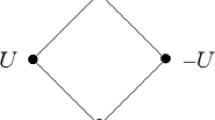Abstract
If there are vague numbers, it would be easier to use numbers as semantic values in a treatment of vagueness while avoiding precise cut-off points. When we assign a particular statement a range of values (less than 1 and greater than 0) there is no precise sharp cut-off point that locates the greatest lower bound or the least upper bound of the interval, I should like to say. Is this possible? “Vague Numbers” stands for awareness of the problem. I do not present a serious theory of vague numbers. I sketch some reasons for using a many-value semantics. These reasons refer to my earlier treatments of determinacy and definitions of higher-order borderline cases. I also sketch how definitions of independence use the determinacy operator. The distinction between actually assigned values and values whose assignments are acceptable helps avoid unwanted precise cut-off points.
Similar content being viewed by others
References
Cargile, James (1969): “The Sorites Paradox,” British Journal for the Philosophy of Science, Reprinted in Keefe, Rosanna, and Smith, Peter, eds. (1995): Vagueness: A Reader, Cambridge: MIT Press, 89–98.
Kaufman, A. and Gupta, M. M. (1985): Introduction to Fuzzy Arithmetic, New York: Van Nostrand Reinhold.
Sanford, David H. (1970): “Disjunctive Predicates,” American Philosophical Quarterly, 7, 167–72.
Sanford, David H. (1975a): “Borderline Logic,” American Philosophical Quarterly, 12, 29–39.
Sanford, David H. (1975b): “Infinity and Vagueness,” Philosophical Review, 84, 520–35.
Sanford, David H. (1976): “Competing Semantics of Vagueness: Many Values Versus Super-Truth,” Synthese, 33, 195–210.
Sanford, David H. (1977): Review of Perception, Common Sense, and Science by James W. Cornman, Philosophy of Science, 25, 163–5.
Sanford, David H. (1979): “Nostalgia for the Ordinary: Comments on Papers by Unger and Wheeler,” Synthese, 41, 175–84.
Sanford, David H. (1981): “Independent Predicates,” American Philosophical Quarterly, 18, 171–4.
Sanford, David H. (1984): “Infinite Regress Arguments,” James H. Fetzer (ed.), Principles of Philosophical Reasoning (Totowa, Rowman & Allanheld), 93–117.
Sanford, David H. (1993a): “The Problem of the Many, Many Composition Questions, and Naive Mereology,” Nous, 27, 219–28.
Sanford, David H. (1993b): Review of Vagueness by Linda Claire Burns, Mind, 102, 357–60.
Sanford, David H. (1994): “A Grue Thought in a Bleen Shade: ‘Grue’ as a Disjunctive Predicate,” Grue!: Essays On The New Riddle of Induction, ed. Douglas Stalker, Chicago: Open Court, 173–92.
Sanford, David H. (2002): “Determinates vs. Determinables,” Stanford Encyclopedia of Philosophy, http://plato.stanford.edu/contents.html.
Van Inwagen, Peter (1990): Material Beings, Ithaca: Cornell University Press.
Van Inwagen, Peter (1993): “Naive Mereology, Admissible Valuations, and Other Matters,” Nous, 27, 229–34.
Author information
Authors and Affiliations
Rights and permissions
About this article
Cite this article
Sanford, D.H. Vague numbers. Acta Analytica 17, 63–73 (2002). https://doi.org/10.1007/s12136-002-1004-6
Received:
Issue Date:
DOI: https://doi.org/10.1007/s12136-002-1004-6




